Mason and Carpenter Bees: Discover the intriguing differences between these two buzzing beauties in the complex world of insects.
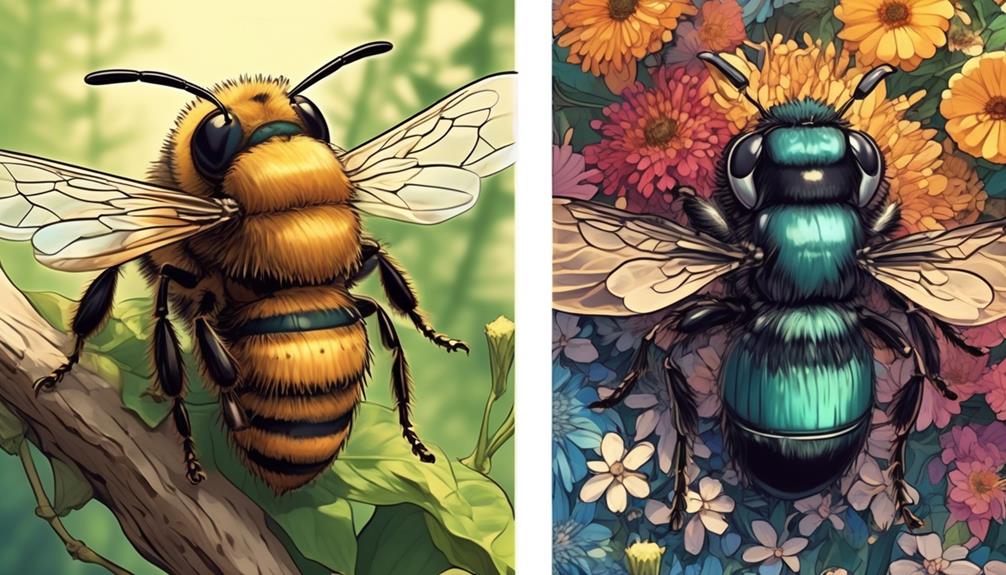
Are Mason Bees Carpenter Bees
Believers in the beauty of buzzing bees, you might find yourselves befuddled by the apparent similarities between the mason and carpenter varieties. They're both bees, right? Indeed, but as you're about to discover, that's where most of the similarities end.
Both have unique characteristics that set them apart in the complex world of insects. Just how different are they? You'll have to stick around to find out.
Key Takeaways
- Mason bees and carpenter bees are both part of the Apoidea superfamily, but they belong to different genera (Osmia for mason bees and Xylocopa for carpenter bees).
- Mason bees are solitary creatures that construct their nests using mud or clay, while carpenter bees bore into wood to create tunnels for their nests.
- Mason bees are highly efficient pollinators, able to do the work of several honeybees in less time, while carpenter bees contribute to forest ecology by providing habitats for other insects and aiding in the decomposition of deadwood.
- Both mason bees and carpenter bees play important roles in ecosystem functioning through their pollination activities, supporting plant reproduction and contributing to biodiversity and food production. Conservation of these bees is crucial for maintaining ecosystems.
Understanding Bee Basics
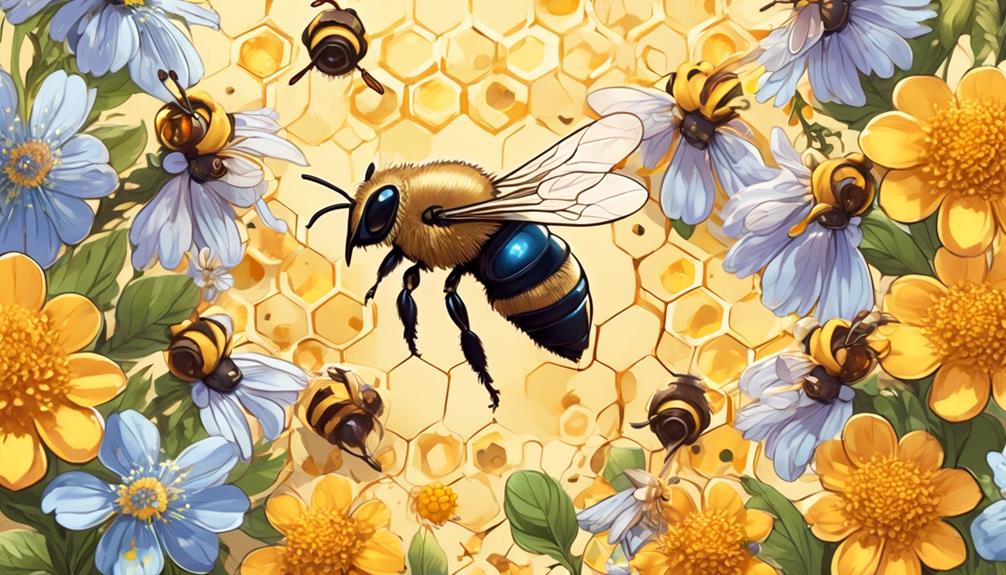
To grasp the differences between mason bees and carpenter bees, you'll first need to familiarize yourself with some fundamental aspects of bee biology and behavior. Both species are part of the superfamily Apoidea, yet their lifestyles, nesting habits, and impact on human activities vastly differ.
Mason bees, belonging to the genus Osmia, are solitary creatures. They're named for their unique nest-building behavior. You'll often find them nesting in pre-existing holes in wood or hollow stems, sealing the entrance with a mixture of mud and saliva. Their non-aggressive nature and high pollinating efficiency make them a gardener's best friend.
On the other hand, carpenter bees, from the genus Xylocopa, are known for their wood-boring behavior. They're capable of drilling into wood to make a nest, which can cause significant damage to human structures. Unlike mason bees, carpenter bees can be quite territorial.
Understanding these basic behaviors and characteristics is crucial in differentiating between these two species. Remember, not all bees are created equal. Your newfound knowledge should allow you to identify and appreciate the uniqueness of these remarkable creatures.
Exploring Mason Bees
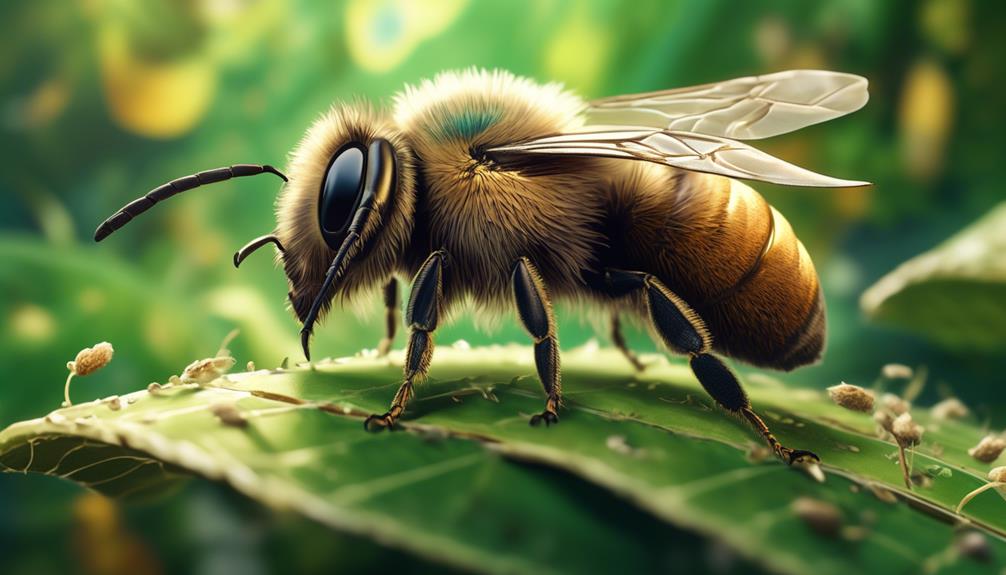
Let's dive deeper into the world of mason bees, solitary pollinators renowned for their industrious nature and unique nest-building skills. Unlike honeybees, mason bees don't live in colonies, nor do they produce honey. They're solitary creatures, each female constructing her own nest and laying her eggs.
Mason bees are named after their habit of using mud or clay ("masonry") to build their nests. They prefer to nest in pre-existing holes, often in wood or hollow stems. They're known for their efficiency as pollinators, being able to do the work of several honeybees in a fraction of the time.
Now, let's look at some fascinating facts about mason bees:
Fact | Description |
|---|---|
Lifespan | Adult mason bees live for about a month |
Pollination Efficiency | A few hundred can pollinate an acre of apples |
Nesting | They prefer pre-existing holes |
Habit | Solitary, not living in colonies |
Food | They feed on nectar and pollen |
Diving Into Carpenter Bees
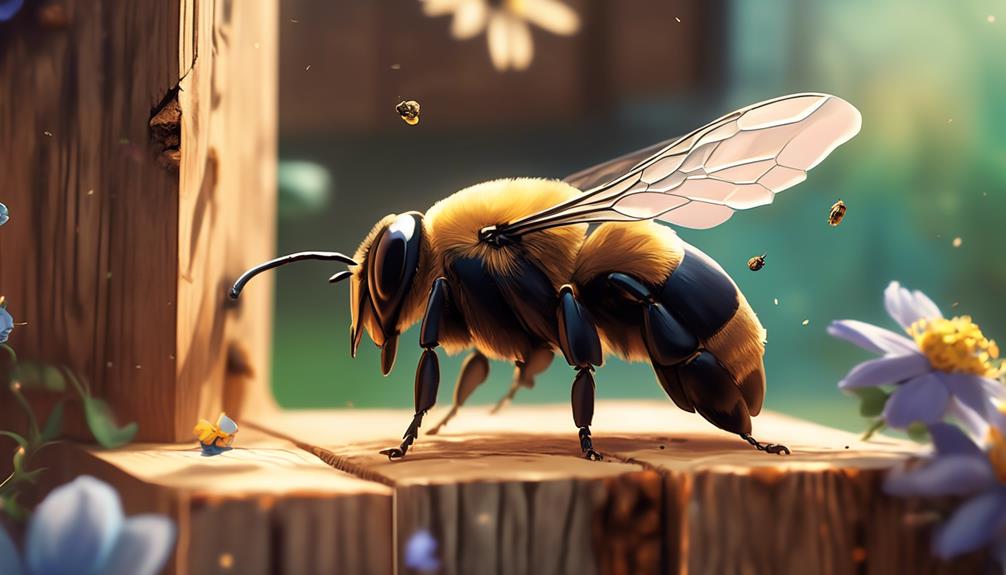
Shifting our focus from the industrious mason bees, you'll find carpenter bees equally fascinating with their unique lifestyle and nesting behaviors. These bees, belonging to the genus Xylocopa, are known for their striking ability to burrow into wood to create their nests, hence their name.
Unlike mason bees that use mud, carpenter bees excavate tunnels in dead wood, bamboo, or structural timbers. You might spot a perfect round hole, about half an inch in diameter, a sure sign of their presence. Inside, they carve out a series of chambers for their young.
Carpenter bees are solitary creatures. Each female is capable of reproducing and tends to her own nest. Males, though appearing aggressive with their territorial flying, can't sting. Their boldness is merely for show.
You see, these bees aren't just pests causing structural damage. They play a crucial role in pollination, particularly of open-faced flowers. So, next time you spot a carpenter bee, remember, it's not just a wood-boring insect, but a vital pollinator, contributing significantly to our ecosystem. With this understanding, you'll view these hardworking insects in a new light.
Key Differences and Similarities
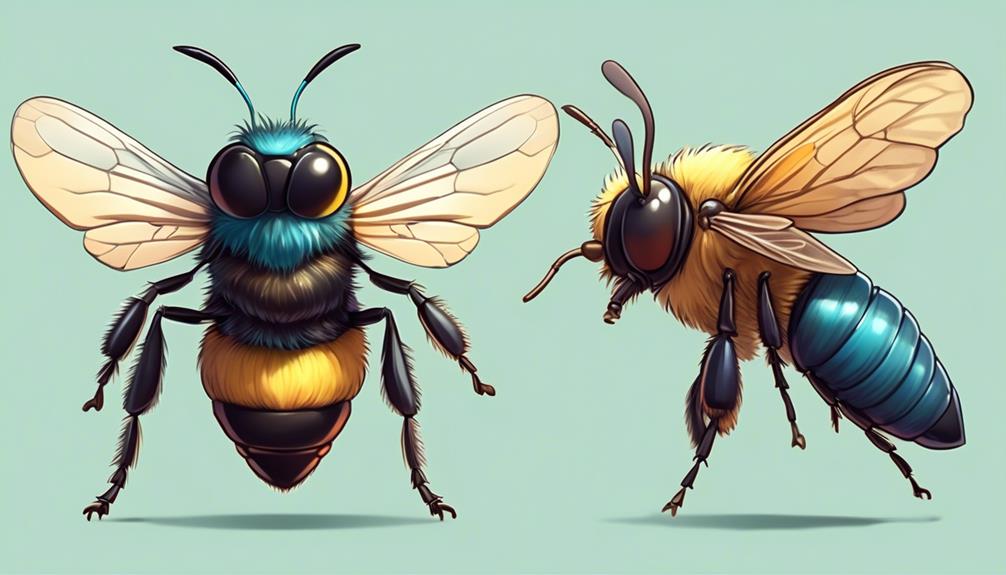
As you delve deeper into the world of bees, you'll discover both stark differences and intriguing similarities between mason and carpenter bees, each species showcasing unique traits along with shared characteristics.
Mason bees, for instance, are solitary creatures that nest in pre-existing holes and crevices, using mud as a sealant, hence their name. They're smaller, metallic-colored, and known for their exceptional pollinating abilities.
On the other hand, carpenter bees are larger, often mistaken for bumblebees due to their size and furry abdomen. They exhibit a fascinating behavior of burrowing into wood to create nesting galleries, showing their adeptness at carpentry.
Despite these differences, you'll find shared traits too. Both species aren't aggressive unless provoked, they're vital for ecosystem functioning due to their pollination activity, and they both operate independently rather than in social colonies like honeybees.
However, it's important to note that while mason bees are generally welcomed for their pollinating prowess, carpenter bees, due to their wood-boring habits, can be seen as pests. Although both play pivotal roles in our ecosystems, understanding these differences can help in better managing and conserving these remarkable creatures.
Impact on Our Ecosystem
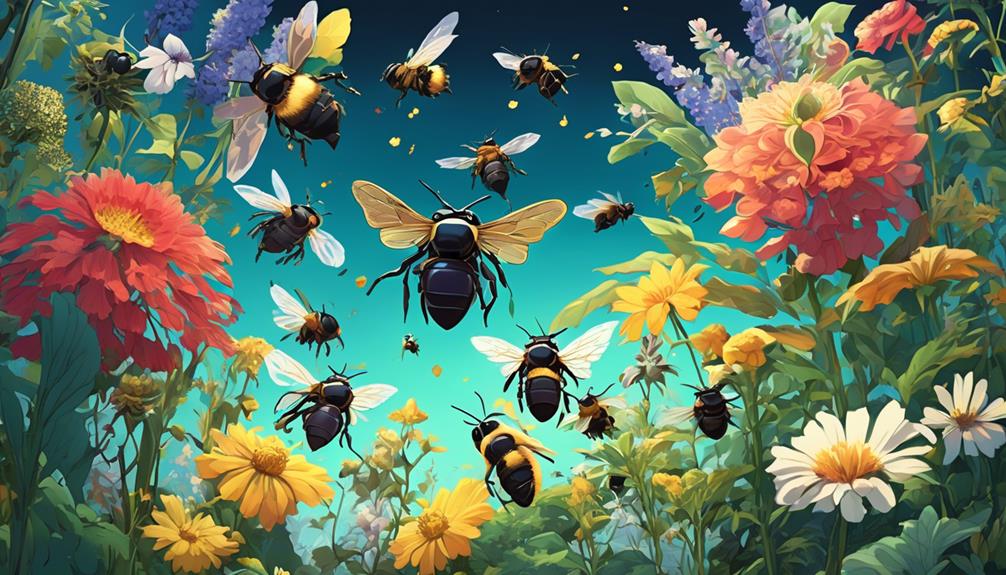
Delving into the ecological footprint of mason and carpenter bees, you'll find that their pollination activities profoundly shape our ecosystems, contributing significantly to biodiversity and food production. Their work isn't merely a matter of transferring pollen from one flower to another; it's a vital biological process that supports the reproductive cycle of plants, including the very crops that make up the bulk of our diets.
Mason bees, for instance, are solitary creatures with a pollen-carrying capacity that outperforms even the industrious honeybee. As they busily construct their nests in hollow stems or crevices, they disperse pollen with remarkable efficiency, enhancing the productivity of various plants.
Carpenter bees, on the other hand, are known for their wood-boring behavior. Although this might seem destructive, it's an integral part of forest ecology, providing habitats for other insects and contributing to the decomposition of deadwood.
Through their respective roles, mason and carpenter bees reinforce the intricate web of life, underscoring the importance of conserving these often overlooked pollinators.
Frequently Asked Questions
What Are Some Common Misconceptions About Mason and Carpenter Bees?
You might think mason and carpenter bees are the same – they're not. A common misconception is they're both destructive. Actually, carpenter bees tunnel into wood, potentially causing damage.
Mason bees, however, are harmless to structures. They're often confused with honeybees, but neither are honey producers. Also, they're solitary bees, not living in hives like many believe.
Understanding these differences helps you appreciate their unique roles in our ecosystems.
How Can Homeowners Safely Remove Mason or Carpenter Bees From Their Property?
No, Mason Bees aren't Carpenter Bees. You're mistaken if you think they're the same.
Mason bees are solitary creatures that lay eggs in small holes, filling them with food for their offspring. They're harmless and beneficial for pollination.
On the other hand, Carpenter bees are known for boring holes into wood to lay their eggs, which may cause damage.
What Role Do Mason and Carpenter Bees Play in Pollination Compared to Honey Bees?
You're curious about the pollination roles of mason and carpenter bees compared to honey bees.
Well, mason and carpenter bees are solitary pollinators. They're not as efficient as honey bees in pollination since they don't have colonies. However, they're essential for pollinating native plants that honey bees might ignore.
In short, they're valuable players in our ecosystem, complementing the work of honey bees and ensuring biodiversity.
Can Mason or Carpenter Bees Be Harmful or Beneficial to Humans?
No, Mason bees aren't Carpenter bees. While they both belong to the bee family, they're different species with unique behaviors.
Mason bees are solitary, non-aggressive bees known for their efficient pollination.
Carpenter bees, on the other hand, can be pests. They bore into wood to create nests, which might cause damage if it's your home they've chosen.
What Are Some Signs That Mason or Carpenter Bees Could Be Present in Your Home or Garden?
You might spot Mason or Carpenter bees around your home or garden if you see small piles of sawdust, or notice round, smooth holes in wood. They're attracted to bare, weathered wood.
Look for bees hovering around your house, shed, or deck. If you see large, black bees hovering alone, they're likely Carpenter bees. Mason bees, on the other hand, are smaller and metallic blue or green.
Conclusion
In conclusion, you've learned that mason bees aren't carpenter bees. They differ in nesting habits, appearance, and behavior.
Yet, they share a critical role in our ecosystem as potent pollinators.
It's important to appreciate both for their unique contributions, and not mistake one for the other.
Now, you're equipped with the knowledge to identify these fascinating insects and understand their integral role in maintaining our planet's biodiversity.



